Today, bicycles are an indispensable vehicle for a modern person: they allow you to quickly move around both in the city and beyond. Necessary accessories for any bike are not only a pump, chain lubricant or repair kit, but also reliable anti-theft equipment. This article will cover all the important information about bicycle locks: about the varieties of such devices, the effectiveness of certain types and the rules for their selection.
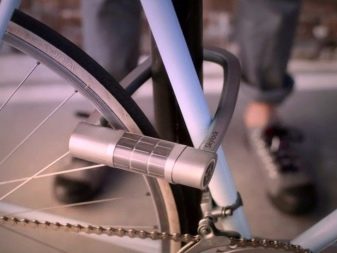
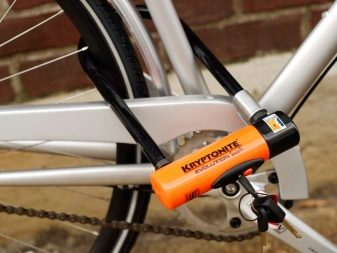
Purpose and requirements
With the development of cycling and the increase in the number of bicycles on city streets, the question arises of how to protect them from intruders and thieves. Despite this, today bicycle locks of any type carry out several key functions at once.
- Protective function. The main reason for buying a bicycle lock for each owner is the ordinary protection of their vehicle from theft. In the manufacture of high-quality bicycle locks, most of the options for breaking the lock or violating the integrity of the device are provided. With the right lock, this allows you to hold the thief behind the bicycle theft for the longest time and reduce the chance of breaking.
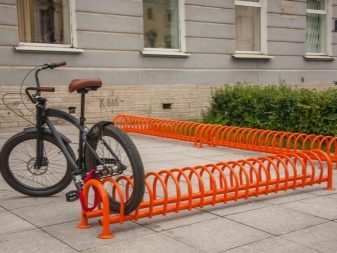

- Latching function. Good bicycle locks can not only protect your vehicle, but also qualitatively fix it in a certain position. Thanks to this, you can safely leave your bike in any convenient place and not be afraid that it will fall or roll somewhere.
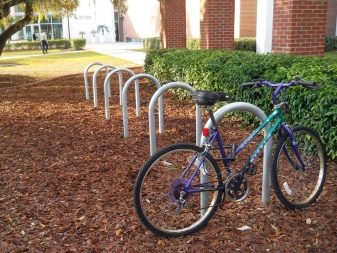
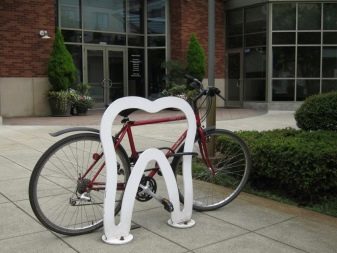
- Decorative function. Every cycling enthusiast tries to be as careful as possible about his two-wheeled friend and monitor his appearance. Today in sports shops you can find bicycle locks in a variety of designs and designs - this will allow the owner to choose the model of the castle that is suitable in color and design.
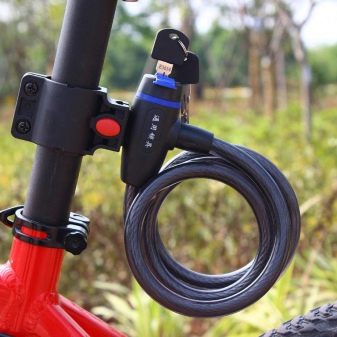
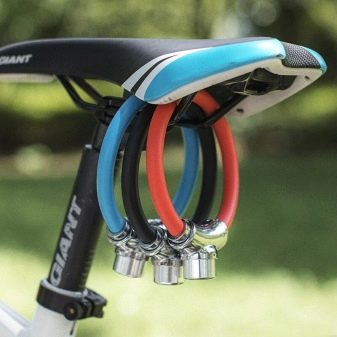
Bicycle locks, depending on their variety, have certain minimum requirements for strength and key parameters.
- Rope. Regardless of the brand of the bicycle lock, it is recommended to buy models with a length of 80 cm or more and a diameter of 7 mm. In large densely populated cities, it is desirable to increase the diameter indicators, but the flexibility of the castle in this case will suffer.
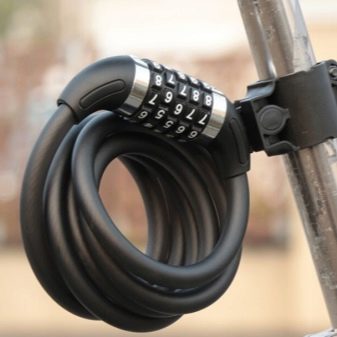

- Chain. Identical requirements are imposed on cycle locks of this format in diameter, as for cable models - at least 7 mm of link thickness. Additional conditions: the chain itself must be short-chain with through hardening.
A protective cover is mandatory for both the chain itself and the device (silicone or rubberized options will be best) - otherwise the formation of scratches from the chain throughout the bicycle is inevitable.
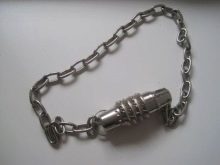
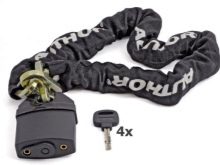
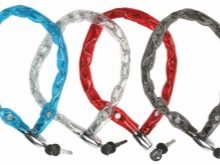
- U-shaped (also called U-Lock). Minimum requirements for a metal bow - diameter from 10 mm, double-sided fixation and through hardening. It is advisable to use models with short brackets - this will bring you a lot of trouble with choosing a place, but it will complicate the attacker to work with his tools due to the tight-fitting bracket to the bicycle frame.
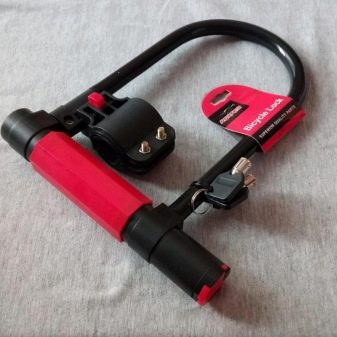
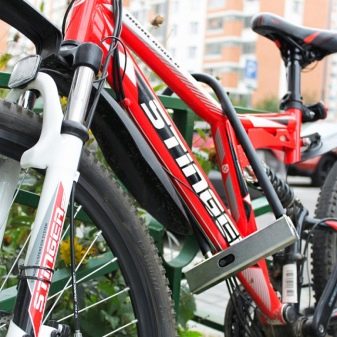
- Lamellar. In this case, the requirements are more of a recommendatory nature - from 80 cm in girth and from 5 mm to the thickness of the red-hot steel segments.
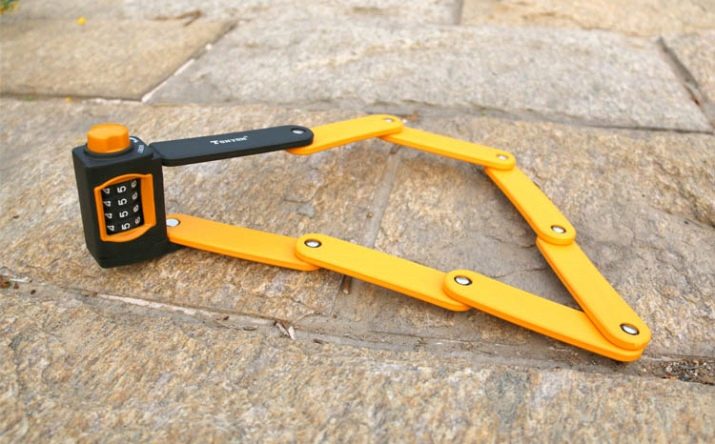
Varieties
A little higher we got acquainted with the common varieties of bicycle locks, then a detailed overview of each of the species will be presented. You can evaluate the pros and cons of certain devices and determine for yourself which of the varieties is best for you.
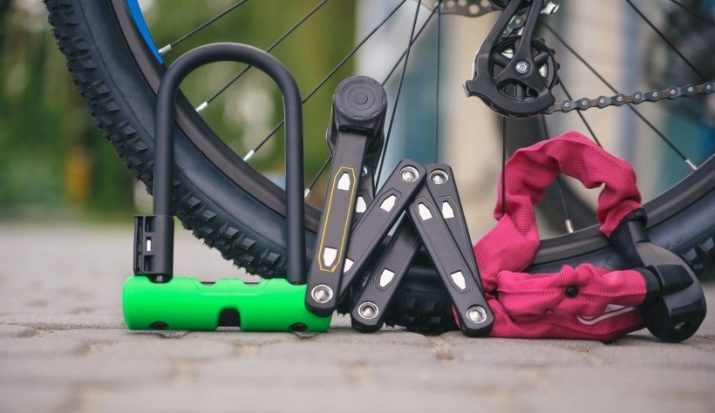
Cable
Cable locks are considered classic defenses against thieves and intruders. Most often, such devices are called cable locks, as they are made of steel cables and have increased flexibility, which is their main advantage.
With the help of such a lock, with a girth of not more than 1.5 m, you can easily wind a whole bike and reach those places where, for example, U-shaped models cannot be used.
Consider the main advantages of such bicycle locks.
- A relatively small cost - from 3-5 dollars per piece.
- Increased flexibility and long length.
- The ability to protect several bicycles at once.
- Light weight in comparison with devices of other types (from 300 g). You can easily carry with you in a backpack, or attach to the bike itself.
- The rubberized cable does not spoil the appearance of the frame and does not leave scratches.
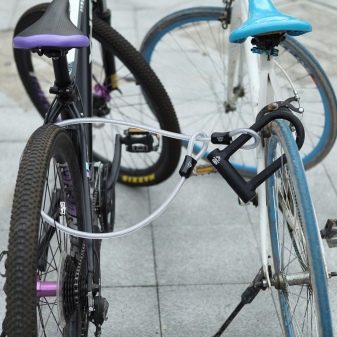

Minuses:
- considered the most unsafe option for long parking;
- most of the models have a free meal with a bolt cutter;
- A simplified locking mechanism in budget models that is easy to crack.

Despite their excellent flexibility, such locks are usually used as additional protection for long parking or races.
It is recommended to use such models when fastening the wheels, and leave the frame guards in U-shaped or chain versions.
Professional cyclists prefer not to use these locks in long-term parking. Almost any steel cables, even rubberized ones, can easily be bitten by working pliers or a bolt cutter for 3-4 minutes.
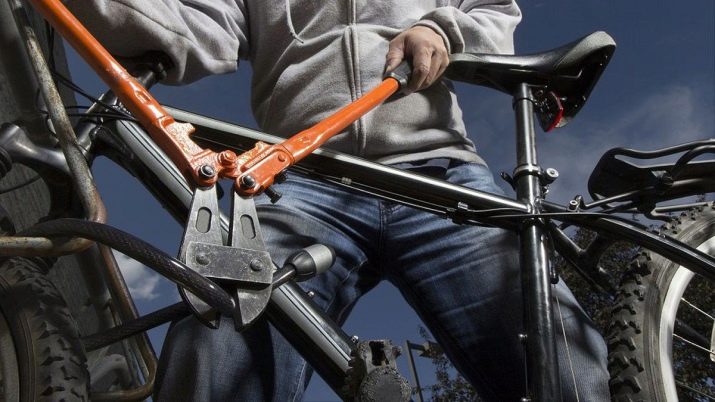
It is because of such a low degree of protection that these models are recommended to be used only in short parking lots - during shopping trips, for example.
In the event that cable devices are the most convenient option for you, but you often leave the bicycle for a long time outside the home, it is worth buying a model of such a lock with a thickness of at least 1.8 cm. It’s not scary if the braid is included in the thickness indicators - it will also significantly complicate biting for most tools.
As an additional protective accessory in such locks, an alarm system can be installed that will inform about attempts to break into the mechanism or bite the cable. Models with installed alarms are also called sound or smart. Unfortunately, the alarm mechanism can also be damaged, which negates its usefulness.
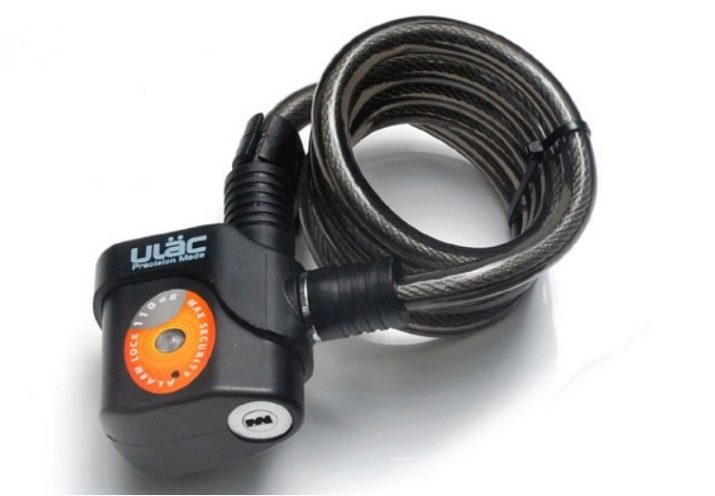
Chain
Such devices are a triple-hardened galvanized anti-theft chain, usually with a tight braid. An obvious plus of such models is that reinforcing scissors against them will be absolutely useless. Such a bicycle lock will be able to eat only a massive meter bolt cutter, which not every thief will have with him. Despite the relative reliability of such a lock, you should not leave the bicycle under its protection for a long time. Some thieves can be quite persistent to simply cut the links of the device.
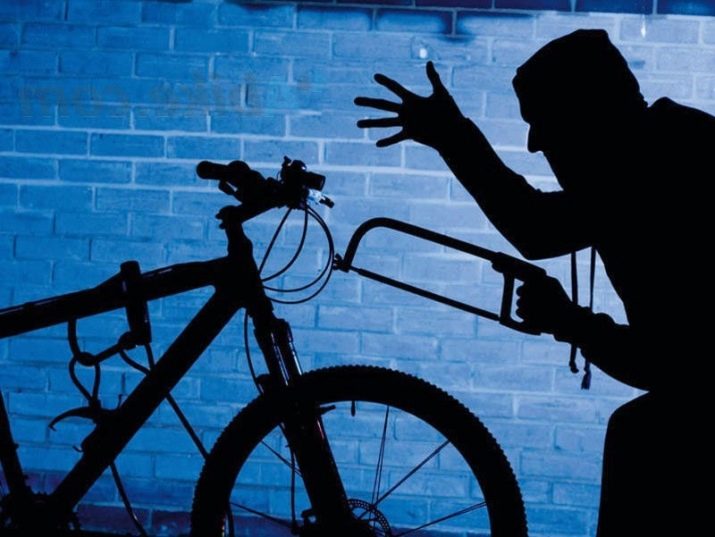
The advantages of chain locks:
- high-quality red-hot chain is extremely difficult to cut, as well as damage;
- medium flexibility that allows you to leave the bike in any convenient place;
- good length, so it is possible to mount two bicycles at once.
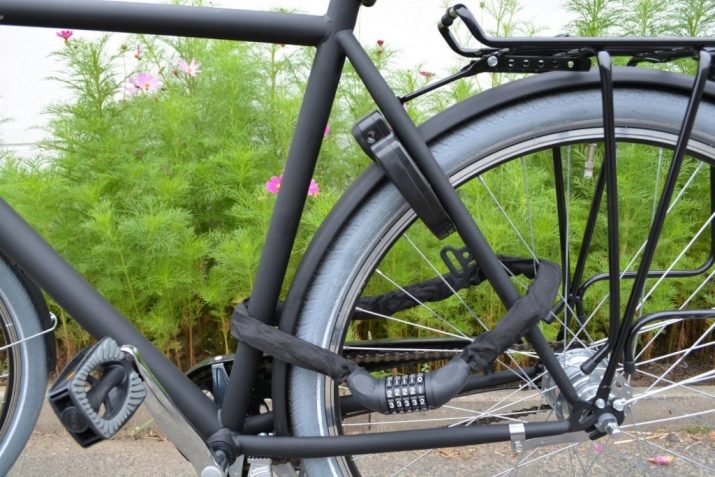
Minuses:
- overpriced for high-quality models - from $ 15;
- durable and high-quality chains weigh at least 1.5 kg, which complicates the transportation of the chain in a backpack or bicycle;
- the need to use a braid for the chain, so as not to harm the appearance of the bike.
There are 2 options for chain locks: with built-in and padlocks. Directly locking mechanisms can be either with a code or with keys.
If you prefer key options, you should choose a model with a disk mechanism. They are much more complicated than pin cylinders and adequately respond to adverse weather conditions (rain, frost and dirt).
When using this bike lock, a lot depends on the material of the manufacturing links. Chain models with a titanium coating are gaining popularity today.
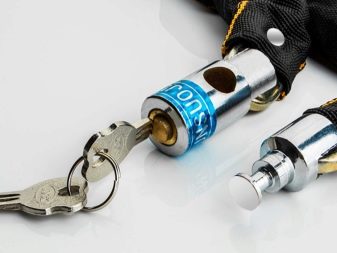
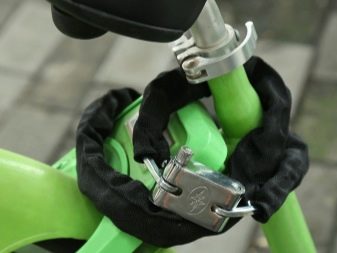
U-shaped
Today, bicycle locks of this type are extremely common both in Europe and in the USA - there They are considered the safest and most reliable anti-theft protection for your bike. Recently, one can observe the spread of these bicycle locks among Russian bicycle enthusiasts.
The principle of operation and design of these units are very simple: the lock is a red-hot bracket with a thickness of at least 10 mm, as well as the cylindrical body itself with a built-in lock. The bracket is threaded around the support, while capturing the bicycle frame and one of the wheels, then the end of the bracket is placed in the locking mechanism and latches. In premium models, there are lock mechanisms of the disk type.
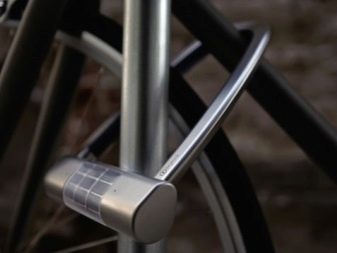
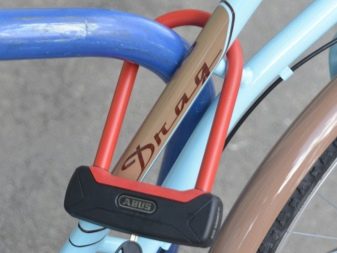
Pluses of the U-shaped lock:
- considered the most reliable type of bicycle lock;
- expensive models are equipped with a special anti-theft cable;
- relatively light weight - starting from 0.7 kg;
- the bike lock is easy to transport, can be mounted on a bicycle holder;
- the ability to install vinyl or rubber braid.
Minuses:
- complete lack of flexibility, the inability to attach to units with a large diameter or thickness;
- the inability to mount two bicycles at the same time;
- not the lowest price compared to cable models - from $ 60;
- unreliable and easily cracked locks in cheap models.
An alarm can also be installed in bicycle locks of this type; a cylinder with a locking mechanism can be either braided or reinforced.
Variants of such a lock, both key and code type, are popular in Europe.
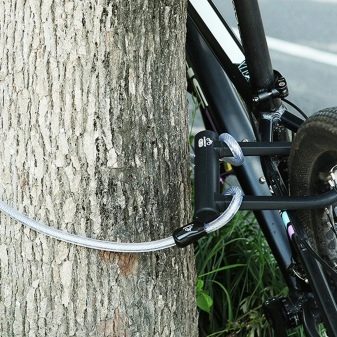
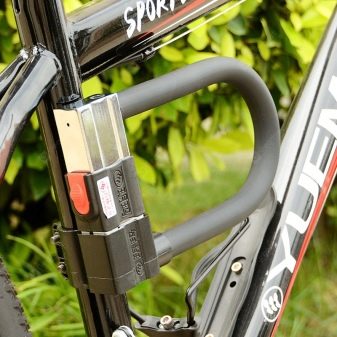
Lamellar
This variety of bicycle assemblies was designed to alleviate the shortcomings of chain and U-lock locks.These locks are notable for their good flexibility and compactness, but they do not perform well in guarding a bicycle near thick posts and trees - the length of such a lock is simply not enough for this. By design, such a lock consists of red-hot steel segments connected to each other. Most often, the thickness of such segments does not exceed 5-6 mm. The peculiarity of such models in the method of fastening to the support is they must cling to high tension to make it difficult for the thief to use any nippers.
Advantages of plate or segment models:
- good flexibility for metal construction;
- high reliability together with another lock;
- compactness - almost all such models fold up very quickly, which facilitates their transportation;
- light weight;
- there is the possibility of rubberizing.


Minuses:
- less reliable than chain or U-lock locks;
- there is no possibility of fastening to thick supports; 2 bicycles cannot be fixed;
- increased cost - from $ 30 and more.

Wheel locks
There are about 5 different types of bicycle wheel locks. Some of them are mounted on disc brakes, others are put on the wheel or couple the wheel to the frame. Unfortunately, all such devices have one significant drawback - they must be used additionally with some kind of lock, since nothing will prevent the thief from simply taking the bicycle with him or loading it into the car.
In addition to the bike locks described above, the Kevlar bicycle unit (made on the basis of steel and Kevlar) is gaining popularity today. These devices are adjustable lightweight straps with a combination lock.


Types of Locking Devices
Locking devices for modern cable locks can be either based on a code mechanism or based on standard keys.
Full construction
It is understood that the locking device is pin cylinder or disk mechanism. The second option of bicycle locks is considered preferable - these locks are much more difficult to open and are resistant to adverse weather conditions.
Turnkey bicycle locks are more reliable in design than models with a code block - the cylindrical case in which such a lock is placed is, as a rule, well-fortified and resistant to physical impact. However, if we talk about the cons, turnkey locks can be cracked by persistent thieves who are not too lazy to pick master keys to them.
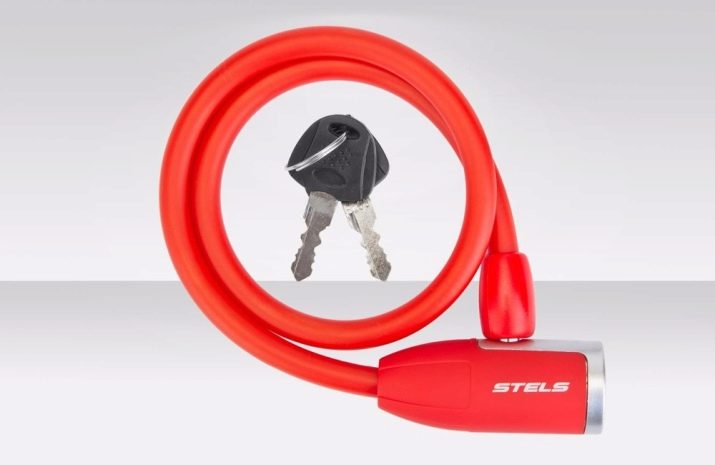
With code block
Models of units of this type are considered a real find for people with poor memory - a code lock will never be lost, the keys to such a lock cannot be forgotten somewhere, because they are not there. All that is required of the owner is to remember a specific 3- or 4-digit code. Cons of such models also have - devices with a code do not have such a powerful design against physical impact as turnkey models. Besides, A bicycle enthusiast hurrying to work or to a store may simply forget to change the code before leaving the bike.
As a rule, the option of buying a key or code unit refers specifically to cable varieties of bicycle locks, however, recently both fastening systems begin to be used in the manufacture of all types of locks.
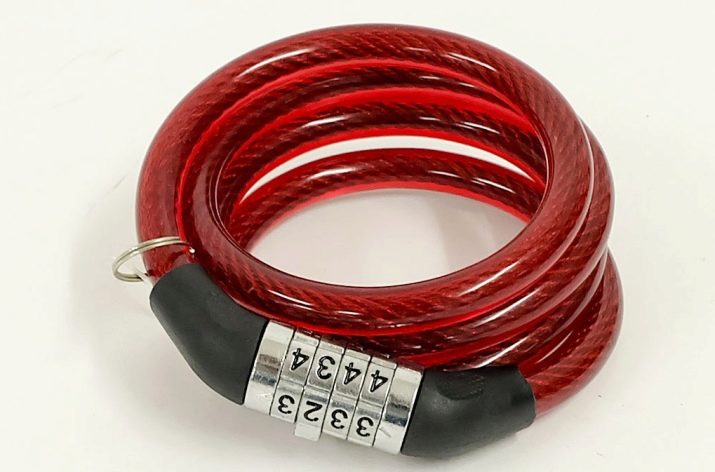
Mounting Methods
Half the success of using any bicycle lock is its proper fixing. Useful tips of experienced motorists will help you position the device correctly, maximally protecting your bike from theft.
- When mounting the device, try to bend around the frame with the lock. If only the wheel protects the lock in the mount, the attacker can safely disconnect it and leave, taking the rest of the bike.
- The unit should not be mounted directly above the ground - this will create an additional lever for the thief when using a bolt cutter.The same applies to attaching the lock to the upper frame - correctly using the pressure from the frame itself, the thief will be able to simply break the lock device. Try to bend around the lock to the lowest frame or frame that is responsible for fixing the seat.
- Position the unit so that it is as open as possible for the potential burglar. For example, if we are talking about a U-Lock lock, then it will be most advantageous if the bracket covers as many frame components as possible and the wheel itself, and does not stick out above the ground. Try to 100% load the space inside the staple, but see that you yourself are then able to remove the lock.
- In the case of using turnkey models, the well with the locking mechanism should be positioned so that it looks down. So the thief will be less convenient to crack the device.
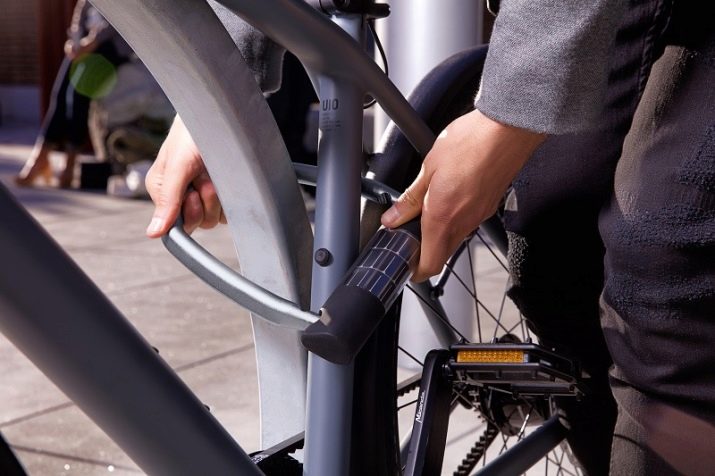
Below you will find the most popular ways to attach a bike lock to a bicycle. Experienced cyclists recommend using exactly two locks when attaching bicycles on the street - one for mounting frame components, the second for wheels.
- Two U-lock locks. One lock covers the seatpost and rear wheel, the next - the lower frame and front wheel.
- U-lock and chain. The first captures the seatpost and rear wheel, the second captures the upper, front wheel and support.
- U-lock and cable. The first covers the seatpost, support and rear wheel, while the cable connects the U-lock and front wheel.
- Method "Sheldon". In this case, only one U-lock is used - the unit is placed directly in the triangle of the frame and connects the wheel and the vertical support. The advantage of this method is that an attacker, even having unscrewed the wheel, will not be able to carry it away without damaging the bicycle.
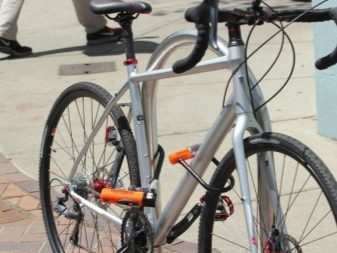
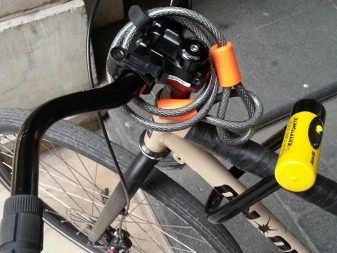
Popular manufacturers
We offer a rating of the most popular manufacturers of quality bicycle locks.
- Abus. This manufacturer is not limited to the release of any specific models of bicycle locks: they produce cable, folding, U-lock, chain locks, as well as high-quality locks. Among the U-lock locks of this brand, the most popular models are the Abus Granit series. Of the chain options for locks, the Lock-Chain Combination Granit CityChain X-Plus 1060 shows itself well.
The most reliable folding lock models of this brand are the Folding Lock Bordo 6000 Twin Set and Folding Lock Bordo Granit X-Plus 6500.
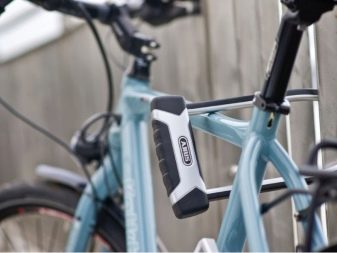
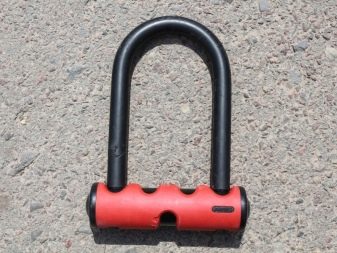
- Cyclotech. The hallmark of this brand is their high-quality combination bicycle locks, but this company also produces chain, cable and U-lock locks. Users of the products of this company note both the durability and reliability of the products, and the high cost of high-quality models of locks.
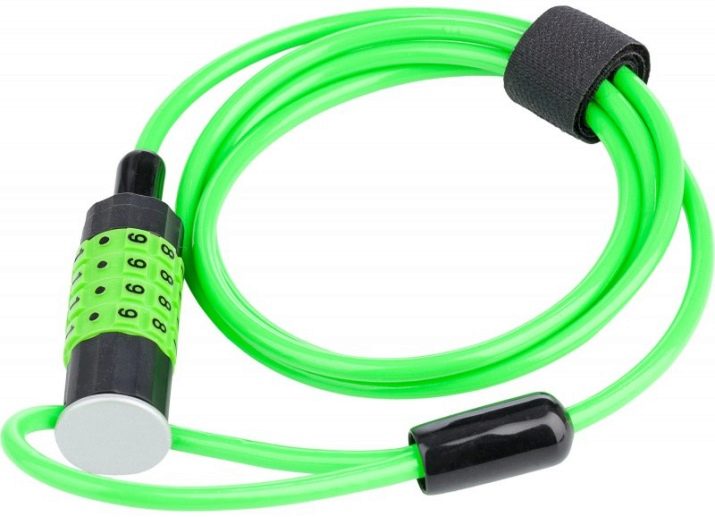
- Kryptonite One of the few companies that produces locks not only for bicycles, but also for other vehicles. U-lock locks of this brand are distinguished by a pleasant design, vinyl coating and an oval shape of a bracket. The company manufactures 3 types of protective aggregates: U-lock, cable and chain. In addition to standard bicycle locks, the company also manufactures durable anti-theft cables.

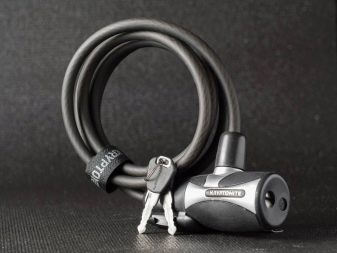
- Knog. Bicycle locks of this brand are extremely popular among cyclists who see in cycling not just sports, but also the possibility of obtaining aesthetic pleasure. The locks of this company, despite their high cost, have an original and minimalist appearance. The company is not fixated on the production of certain types of locks. Today you can find all kinds of bike locks of this brand: folding, U-lock, chain and cable.
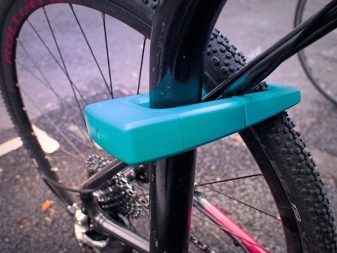
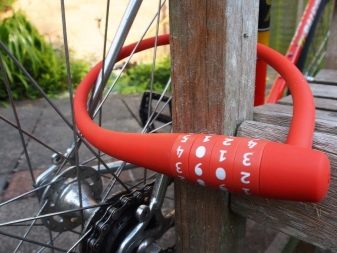
- "Damask steel". One of the most popular bicycle locks in Russia. It features enhanced protection against theft, well protected from the negative effects of adverse weather conditions. Due to the special composition of flexible hardened steel, such locks are extremely difficult to bite or saw. As a rule, when mentioning the models of this brand, we mean models of a cable or chain type with a braid.Here, both a turnkey lock and a code variety can be used.
The obvious advantage of such models, unlike others, is the relatively low cost and great flexibility.
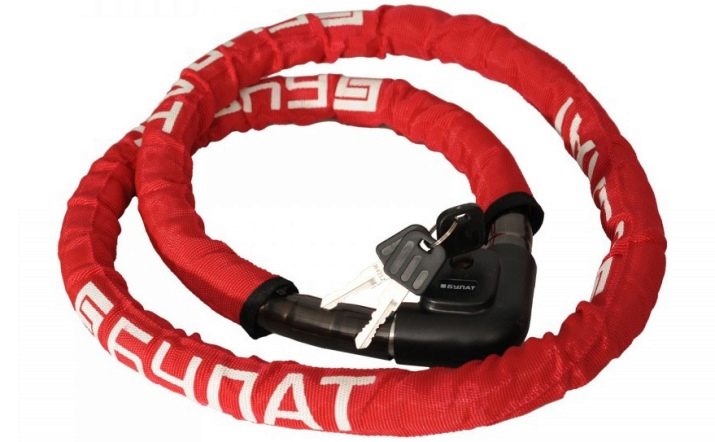
Selection tips
When buying a particular bike lock model, you should pay attention to a number of factors.
- The length of the lock. Keep in mind that far from every building today there is a convenient bicycle parking, where you can easily use even the shortest castle. Try to choose options for bike locks with a length of at least 80 cm, a length of 1.5 m should be enough to protect 2 bicycles.
- Thickness. Some cyclists are of the opinion that the thicker the cable or chain in the lock, the more difficult it will be to bite with a bolt cutter, however, it is worth remembering that the thickness affects the flexibility of the unit.
- Quality, strength and the presence of hardening of steel. These parameters will determine how quickly the thieves manage to cut your castle.
- Price. It is also an important factor, however, remember that it will be cheaper to buy an expensive, but high-quality lock than to stay completely without a bicycle.
- Goals. Before choosing any particular lock, decide why you will need it. If you plan to ride from time to time and occasionally drop by the grocery store on a bicycle, it will be more profitable to dwell on budget options for castles. If you often engage in cycling, often visit the city or beyond, it would be prudent to choose a more expensive model of a bicycle lock.
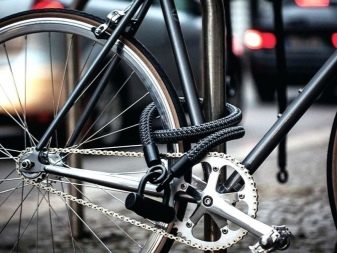
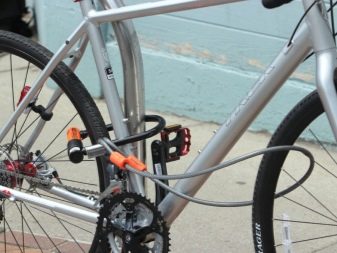
All about bike locks, see the next video.










